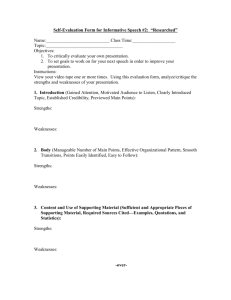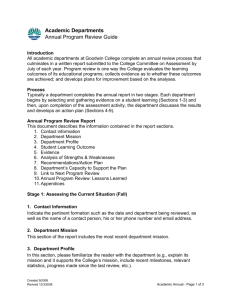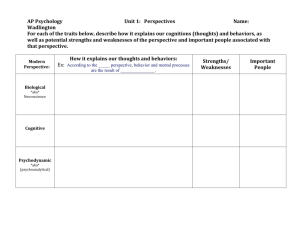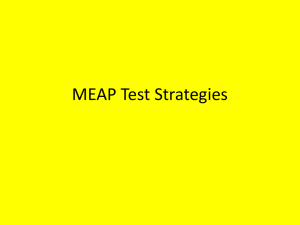Format for Psychosocial Assessment
advertisement
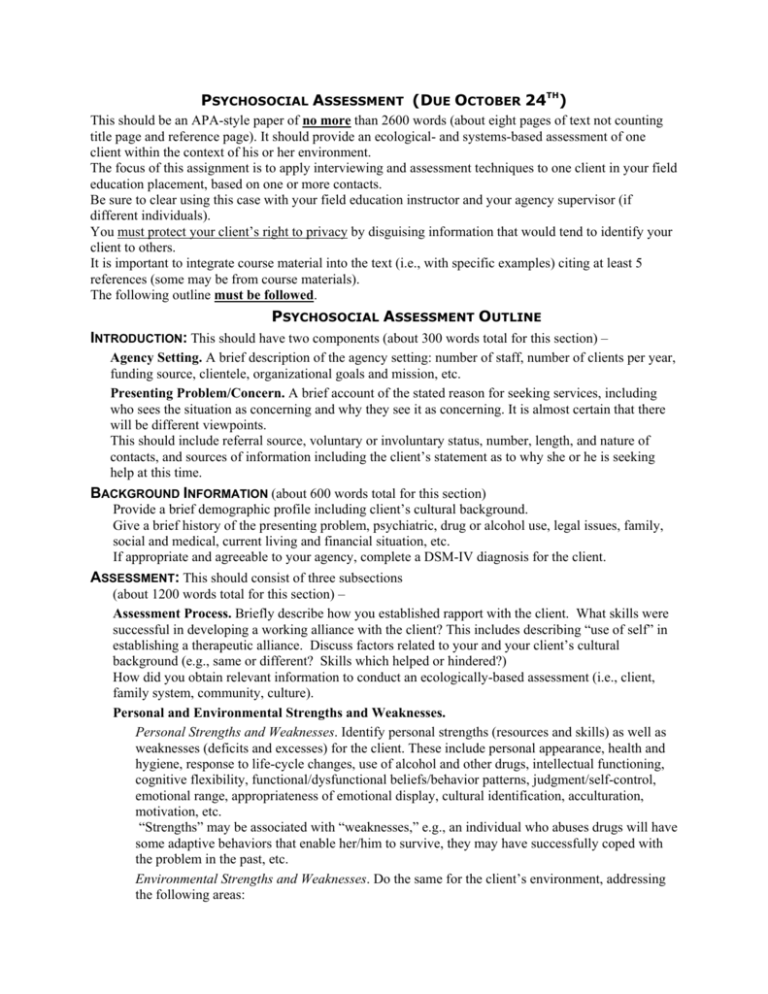
PSYCHOSOCIAL ASSESSMENT (DUE OCTOBER 24TH) This should be an APA-style paper of no more than 2600 words (about eight pages of text not counting title page and reference page). It should provide an ecological- and systems-based assessment of one client within the context of his or her environment. The focus of this assignment is to apply interviewing and assessment techniques to one client in your field education placement, based on one or more contacts. Be sure to clear using this case with your field education instructor and your agency supervisor (if different individuals). You must protect your client’s right to privacy by disguising information that would tend to identify your client to others. It is important to integrate course material into the text (i.e., with specific examples) citing at least 5 references (some may be from course materials). The following outline must be followed. PSYCHOSOCIAL ASSESSMENT OUTLINE INTRODUCTION: This should have two components (about 300 words total for this section) – Agency Setting. A brief description of the agency setting: number of staff, number of clients per year, funding source, clientele, organizational goals and mission, etc. Presenting Problem/Concern. A brief account of the stated reason for seeking services, including who sees the situation as concerning and why they see it as concerning. It is almost certain that there will be different viewpoints. This should include referral source, voluntary or involuntary status, number, length, and nature of contacts, and sources of information including the client’s statement as to why she or he is seeking help at this time. BACKGROUND INFORMATION (about 600 words total for this section) Provide a brief demographic profile including client’s cultural background. Give a brief history of the presenting problem, psychiatric, drug or alcohol use, legal issues, family, social and medical, current living and financial situation, etc. If appropriate and agreeable to your agency, complete a DSM-IV diagnosis for the client. ASSESSMENT: This should consist of three subsections (about 1200 words total for this section) – Assessment Process. Briefly describe how you established rapport with the client. What skills were successful in developing a working alliance with the client? This includes describing “use of self” in establishing a therapeutic alliance. Discuss factors related to your and your client’s cultural background (e.g., same or different? Skills which helped or hindered?) How did you obtain relevant information to conduct an ecologically-based assessment (i.e., client, family system, community, culture). Personal and Environmental Strengths and Weaknesses. Personal Strengths and Weaknesses. Identify personal strengths (resources and skills) as well as weaknesses (deficits and excesses) for the client. These include personal appearance, health and hygiene, response to life-cycle changes, use of alcohol and other drugs, intellectual functioning, cognitive flexibility, functional/dysfunctional beliefs/behavior patterns, judgment/self-control, emotional range, appropriateness of emotional display, cultural identification, acculturation, motivation, etc. “Strengths” may be associated with “weaknesses,” e.g., an individual who abuses drugs will have some adaptive behaviors that enable her/him to survive, they may have successfully coped with the problem in the past, etc. Environmental Strengths and Weaknesses. Do the same for the client’s environment, addressing the following areas: • primary support group (e.g., usually family, relationships with parents, siblings, partner, children, stability of relationships), • social environment (e.g., friends, availability of and participation in recreation, availability of and involvement in social/ cultural/ religious organizations), • education (e.g., level of education, adequacy of educational environment, relationship with teachers/ classmates, opportunities for self-development/ education), • occupation (e.g., work opportunities, employment status, safety and stability of work, work schedule, satisfaction with job, relationship with employer/ co-workers), • housing and neighborhood (e.g., safety, adequacy of space, stability of living arrangements, security/ police/ fire protection), • economic issues (e.g., adequacy of financial resources, sources of financial support, financial obligations), • health/social service issues (e.g., availability of services, relationship with service providers, adequacy of health insurance) • legal system (e.g., legal actions, arrest, crime victim) • other issues (e.g., adequate transportation) “Strengths” may be associated with “weaknesses” here as well, e.g., a tenants organization in a community with substandard housing. Targets and Goals. Briefly summarize three concerns/problems selected for change and goals for these concerns. These concerns and goals must be selected and developed by your client and you. They must be high priority concerns. Define the concerns in an ecological context and operationalize them so that a concrete goal may be selected. Do this in a way that will assist you in selecting an intervention. PRELIMINARY INTERVENTION PLAN Briefly discuss future directions for work with this client. This should include a discussion of the interventions to be used to move the selected concerns from their current status to the goals. (about 400 words total for this section) Concerns and Goals. Identify and specify the central problems/concerns for this client in order of priority. It is generally a good idea to specify only a few central issues. Treatment Plan. Propose a course of treatment including number of sessions, setting, treatment modality, etc. The efficacy of the selected treatment modality should be supported by reference to outcome evaluation research (cite articles from a professional peer review journal). Identify who you would target for the intervention? (i.e., individual client, dyad, family, group, or community). How would your intervention be culturally competent? REFERENCES. The sources cited in your paper should be referenced according to APA guidelines.

